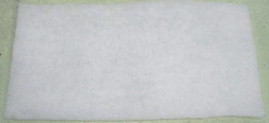
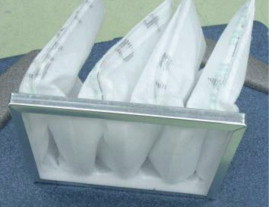
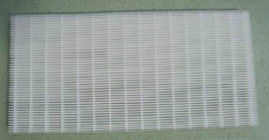
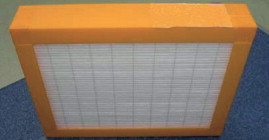
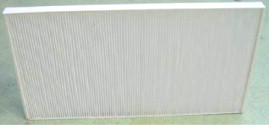
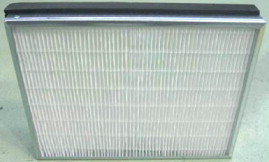
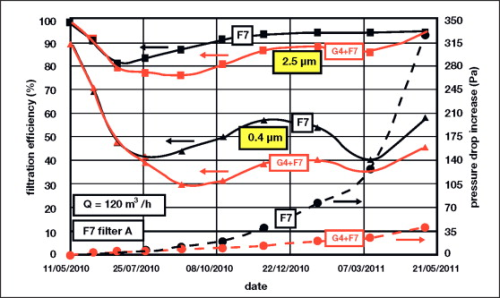
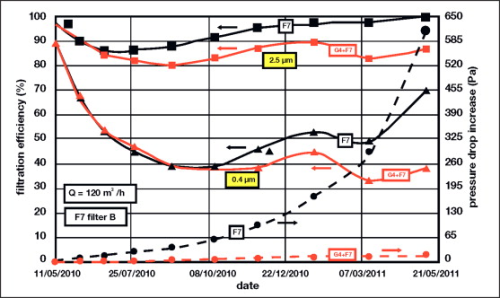
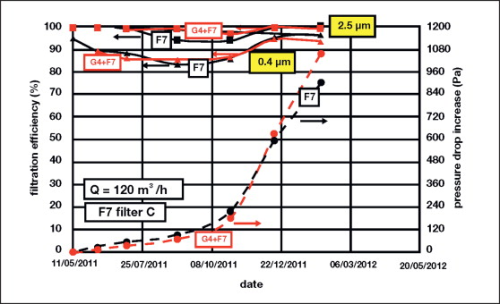
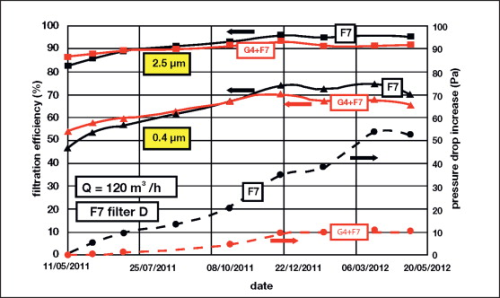
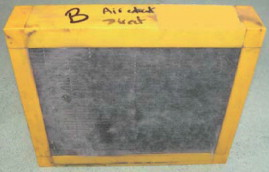
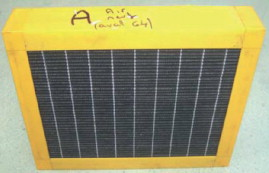
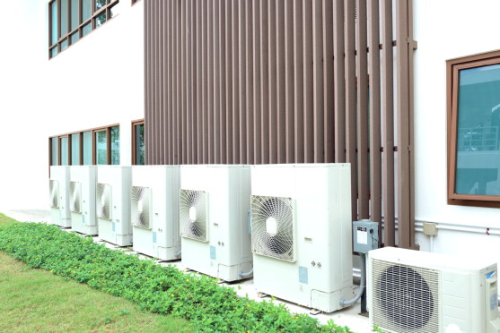
A study has investigated the performances of different kind of outdoor air filters over a year when used in residential balanced ventilation systems. For each experiment, one F7 panel mini-pleated filter was installed in a ductwork while another ductwork was equipped with the same kind of F7 filter protected by a G4 (flat or bag) filter installed upstream. The ductworks were continuously fed with the same outdoor air (constant airflow) and the filters were removed from time to time for performance measurements (pressure drop, mass of retained dust and efficiency by particle size).
Introduction
As a consequence of energy issues and the necessity to reduce the energy consumption of buildings, tighter control of air is now required. In this context, better control of building ventilation is needed and the market for balanced ventilation systems with heat recovery for dwellings is growing. These systems include air filters to protect the heat exchanger (both on the fresh air and exhaust air sides) and to enhance the quality of supplied air. The assessment of thermal, acoustic and air flow performances of balanced ventilation systems for dwellings relies on the European standard EN 13141-7 [1]. National labels provide additional requirements. For example, the ‘NF’ French Label requires that the system provides the minimum air flow in the French regulation when used with a typical ductwork. This label also requires that the filter classes according to EN 779 [2] are at least M5 on the outdoor air and G4 on the exhaust air. All the tests for labelling are operated on new systems. One of the issues is the need to guarantee this level of performance during the real use of the systems. In spite of the recent development of balanced ventilation systems, almost no information is available on the filters’ characteristics and performance changes over time when used in the systems. In order to control the energy consumption of the fans within a balanced ventilation system, it is necessary to define a maximum pressure drop for the filters - above which, filters should be replaced. The objective of the study was to determine the pressure drop increase of filters of balanced ventilation systems for dwellings as they are used continuously in the long-term (1 year) with real outdoor air. The efficiency by particle size as well as the mass of dust collected was also reported. In addition, a new way of filter classification is explored.
Balanced ventilation systems and air filtration
A balanced ventilation system for dwellings is typically composed of one ductwork (including a fan) to supply air from outside indoors and one other ductwork (also including a fan) for indoor air exhaust. A heat exchanger is used at the crossing of the two ductworks between outdoor air and exhaust air, allowing supplied air to be heated during the cold season and cooled during the warm season. The heat exchanger is protected by two filters installed upstream, one on the outdoor air and the other on exhaust air. There is a wide variety of filters on the market including different sizes, shapes, medium configuration, filter medium and class efficiency. A very popular filter type for balanced ventilation systems for dwellings is the panel mini-pleated filter and this is why it was used in the study.
| Filter | X | Y | A | B | C | D |
| Initial pressure drop (Pa) | 6.7 | 7.2 | 8.9 | 15.2 | 70.2 | 20.4 |
| Filter | A | B | C | D |
| Medium | Electret synthetic fibre | Electret synthetic fibre | Electret synthetic fibre | Glass fibre |
| Filtration area (m²) | 0.75 | 0.84 | 0.66 | 1.00 |
| Thickness (mm) | 20 | 44 | 18 | 44 |
| Number of pleats | 47 | 41 | 97 | 59 |
| Pleat width (mm) | 4.1 | 4.0 | 4.0 | 4.4 |
Experimental method
Two different balanced ventilation systems were installed at CETIAT (Villeurbanne, France) for continuous long term running at more or less constant air flow rate (120 m³/h) in order to allow long term (1 year) filter testing with a natural dust loading. The two ductworks of each ventilation system - normally used for outdoor and exhaust air flows respectively - were connected to the same outdoor air inlet. This allows the testing of four different filtration configurations in parallel with the same outdoor air, without changing the way in which the filters were installed (because of the symmetry of the system with respect to outdoor versus exhaust air circuits). It was decided to study F7 panel mini-pleated filters with and without a pre-filter (class G4) installed upstream. F7 filter class is widely used in balanced ventilation systems for dwellings and the pre-filter is intended to prevent fast filter pressure drop increase due to the loading of the F7 filters by particles. For each ventilation system, the F7 filter under investigation is used alone (one ductwork) and protected by a G4 filter installed upstream (the other ductwork). Two different F7 filters (A and B) were studied between May 2010 and May 2011 while two other F7 filters (C and D) were studied between May 2011 and May 2012. A flat G4 filter (X) was used upstream of F7 filters A and C while a bag G4 filter (Y) was used upstream of F7 filters B and D. The filters are shown in Figures 1a, 1b, 2, 3, 4 and 5. The initial pressure drop of filters is reported in Table 1 while the main characteristics of the four different F7 filters are reported in Table 2. The filter media of filters A, B and C were made with electrostatically charged (electret) synthetic fibres while that of filter D was made with glass fibres. The pleat width was about 4 mm for all the F7 filters. The two balanced ventilation systems were regularly stopped (every 6 to 8 weeks) in order to remove the filters for performance measurements (pressure drop, mass of retained dust and efficiency by particle size). The amount of dust retained by the filters was determined by direct weighing of the filters. A test rig used for EN 779 filter testing was used for pressure drop and fractional efficiency (by particle size with DEHS aerosol in the particle size range 0.2-5 μm) measurements.
Results and discussion
Filter performances
Test results are reported in Figures 6 to 9. The pressure drop of the filters continuously increases as function of time (dashed lines). When F7 filters are protected by a G4 filter installed upstream, the pressure drop increase (G4+F7) is much smaller (except for filter C) than if F7 only is used (except for filter C). The majority of the aerosol affecting the filters is arrested by the G4 filters (50-60% by mass for filter A, 65-80% for filter B, 40-45% for filter C, 60-80% for filter D). Loading of the F7 filters is limited and their pressure drop increase is lower (divided by 8 after 1 year of use for filter A, divided by 30 for filter B and by 5 for filter D). It has been observed that when the F7 filter is not protected by a pre-filter, a thin layer of fibres and particles covers the front area of the filter (Figure 10) which is not observed when a pre-filter is used (Figure 11). For filter C, the pressure drop increase was unchanged with or without a pre-filter (the test was stopped after 9 months because the pressure drop was too high). The efficiency of this F7 filter is very high. As well as its initial pressure drop, the amount of dust retained by the pre-filter was not enough to slow down the loading of this F7 filter and the increase of its pressure drop. For this F7 filter a more efficient pre-filter would have been necessary. Whether using a G4 pre-filter or not, the efficiency of filters A, B and C at first begins to decrease. This is a well known phenomenon often described and explained in the literature [3] [4] - dealing with the decrease of the electret effect of the electrostatically charged fibrous medium used by these F7 filters as they become loaded with particles. Because at the same time the efficiency tends to increase through mechanical effects, a point is reached where the efficiency is minimised and obtained after a given period of time (2-4 months). The decrease in efficiency is less pronounced when the F7 filter is not protected by a G4 filter. In this case, more particles are retained by the filters and the efficiency due to mechanical effects increases, while the decrease of the electret effect continues. The efficiency of filter D increases as function of time because this filter uses mechanical effects only.
Filter classification
Filters of balanced ventilation systems for dwellings are usually classified according to EN 779. The use of this classification is in theory not possible because it applies to filters for which air flow rate is above 850 m³/h and the maximum final pressure drop allowed for the use of the classification is too high for the filters being considered (250 Pa for G filters, 450 Pa for M and F filters). A new filter classification (ISO/WD 16890-1 [5]) is being developed at international level (ISO/TC 142/WG3) for the same filters other than those covered in Europe by EN 779. This classification could be used for other types of filters as the parameters taken into account for its use are the initial and the discharge efficiencies. The efficiency of the filters is expressed as a function of their ability to remove PM1, PM2.5 and PM10 (PMx:Particulate Matter whose particles have aerodynamic diameter smaller than x microns). The efficiency by particle size is measured between 0.3 and 10 microns and is mixed with a standard conventional particle size distribution defined for ambient air. The filter class takes into account the average of the new and discharge (min) efficiencies (for a given class, the discharge efficiencies has to be higher than a given value). Those efficiencies have been calculated for the F7 filters tested in our study and the results are reported in Table 3. Results of the calculations show that if the filters had been classified at the same level according to EN 779 (F7), their rankings are now very different according to new ISO/WD 16890-1. The importance of the discharge efficiency is very clear.
Conclusions
As balanced ventilation is increasingly used in dwellings and because it is necessary to reduce the energy consumption of the fans of these systems, the pressure drop increase of the filters throughout their life must be limited. In long term tests of filters typically used for balanced ventilation systems (panel mini-pleated filters), it has been shown in the study that from an energy consumption point of view it is much better to use a F7 filter protected by a G4 filter installed upstream instead of the same F7 filter alone because the pressure drop increase is much lower. More generally, the filtration of the systems has to be well designed in such a way that a pre-filter and a fine filter are used in series (in separate units or in one unit). Further work is now continuing with a study of the influence of the pleat width of the panel mini-pleated filters on the pressure drop increase. Energy saving issues should not reduce indoor air quality. The efficiency of the filters has to be high enough to ensure that a balanced ventilation system will provide clean air to the building and its occupants. Engineers have to design filters with an acceptable pressure drop increase together with good filtration efficiency - this compromise is still difficult to achieve. The EN 779 standard cannot be used to classify filters of balanced ventilation systems for dwellings despite the fact that this is a common practice. The method developed in the ISO/WD 16890-1 draft standard appears to be appropriate for the classification of filters used in balanced ventilation systems for dwellings.
References
[1] NF EN 13141-7. 2011. Ventilation for buildings – Performance testing of components/products for residential ventilation – Part 7: Performance testing of a mechanical supply and exhaust ventilation units (including heat recovery) mechanical ventilation systems intended for single family dwellings. [2] NF EN 779. 2012. Particulate air filters for general ventilation – Determination of the filtration performance. [3] Drangsholt F. 1995. Long-term tests of filters in a real environment. STF11 A95052 Report, SINTEF, Trondheim, Norway, 44 pages. [4] Gustavsson J., Ginestet A., Tronville P. and Hyttinen M. 2010. Air filtration in HVAC systems. REHVA Guidebook No 11, 94 pages. [5] ISO/WD 16890-1. 2012. Air filters for general ventilation – Part 1: Technical specifications, requirements and efficiency classification system based upon particulate matter (PM).
This study has been financially supported by both the Ventilation and Filtration CETIAT technical committees. The authors are grateful to the manufacturers who have provided the balanced ventilation systems as well as the filters under study.
| Filter | A | B | C | D |
| E PM1 new (%) | 90.5 | 89.4 | 96.9 | 63.8 |
| E PM1 min (%) | 18.1 | 14.0 | 52.9 | 61.4 |
| E PM1 (%) | 54.3 | 51.7 | 74.9 | 62.6 |
| E PM2.5 new (%) | 94.4 | 94.3 | 98.7 | 79.3 |
| E PM2.5 min (%) | 33.4 | 29.4 | 77.4 | 77.6 |
| E PM2.5 (%) | 63.9 | 61.9 | 88.1 | 78.5 |
| E PM10 new (%) | 97.6 | 97.9 | 99.7 | 92.8 |
| E PM10 min (%) | 70.6 | 69.4 | 93.9 | 92.5 |
| E PM10 (%) | 84.1 | 83.7 | 96.8 | 92.7 |
| Class | ISO 80% PM10 | ISO 80% PM10 | ISO 70% PM1 | ISO 60% PM1 |
As per ISO/WD 16890-1. The fractional efficiency was measured on DEHS but should normally be measured on KCl for particles larger than 1 micron. The efficiency between 5 and 10 microns was not measured but extrapolated.





